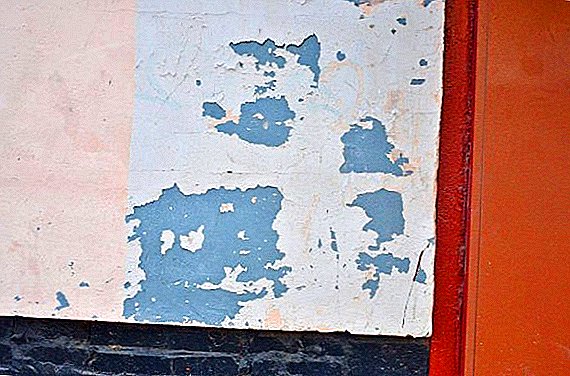 Planning the painting of the walls, the first task faced by the master is the removal of the old coating. Due to inexperience, someone may think that this is not an important aspect, however, such levity can further adversely affect the final result.
Planning the painting of the walls, the first task faced by the master is the removal of the old coating. Due to inexperience, someone may think that this is not an important aspect, however, such levity can further adversely affect the final result.
Why, and most importantly, how to do it correctly, you need to know to everyone who is planning to repair their own hands. Therefore, today we will talk more about how to remove paint from various surfaces.
Do I need to remove old paint
If during repair the wall with the old paint will be closed with drywall, then there is no need to spend time fighting the remnants. But if the plans include the treatment of this particular surface, then the previous coating will have to be removed.
Otherwise, the tile will not stick (and even if it is fixed, it will disappear very quickly), and the wallpaper will move away as soon as the glue dries. How the new paint will behave on the old, it is impossible to predict at all. 
Did you know? The word "repair" comes from France. Originally it was used in the army in the sense of "change the old horse to the young."In order to remove the previous decor sooner and with the least effort, you need to answer a few questions:
- what paint is on the wall now, how many layers;
- what type of surface we are dealing with;
- what tool is available;
- event budget.
Most often, the difficulty is precisely the first point. Paint can be acrylic, water emulsion or oil. If an experienced master can easily determine the type of painting, it is impossible to guess the layers. Therefore, it is recommended to choose a small area of the wall for experiments, so that it is possible to determine the most effective cleaning method in practice.
The type of surface is usually easy to distinguish even for a beginner: wood, metal or concrete. The most difficult to remove is oil paint and concrete.
We will dwell on the instrument in more detail. 
Learn how to build a cellar with ventilation, a sheepfold, a chicken coop with ventilation, a veranda, a gazebo, barbecue, a fence with your own hands.
Necessary tools and materials
Usually for removal of an old covering are used:
- spatula, metal scraper, chisel;
- ax;
- building hair dryer;
- the Bulgarian or the electric drill with various nozzles;
- paint removal chemicals;
- water.
Important! Be sure to remember to use gloves, goggles, and a respirator to protect against dust and fumes.
Paint stripping methods
At the moment, experts have identified the three most effective ways to remove old paint. Each of them has its minuses and advantages, the technology of work, so it is worthwhile to talk in more detail about each of them.
Chemical
Its essence lies in the use of various liquids (alkaline and organic), which produce the effect due to the mixing of active substances in their composition.  The process of removing paint is described in detail in the instructions for chemical means and may vary depending on the brand, but in general terms it looks like this:
The process of removing paint is described in detail in the instructions for chemical means and may vary depending on the brand, but in general terms it looks like this:
- The composition with a brush or roller is applied to the coating, which must be removed for 10-15 minutes.
- After this, the softened paint is removed with a metal spatula or chisel.
- Depending on the number of layers and the timing of their application, the procedure sometimes needs to be repeated several times.
- If the previous surface painting was carried out more than two years ago, then chemistry is unlikely to cope with it.
Did you know? In the modern world, walls are built of brick, concrete, wood, metal and ... salt. This method is practiced in some regions of Africa, where there are deposits of this mineral. It seldom rains in those parts, therefore the walls serve for a long time.
- The constant companion of chemically active compounds is a persistent odor. He not only possesses unpleasant for a person, but also carries a threat to his health. Therefore, when working, it is necessary to cover the face with a respirator, as well as to ensure that there are no children, animals or pregnant women nearby.

Find out what are the seed drills, headers, how to choose a seed drill for gardening, how to make an extruder, potato planter, potato digger, hiller, honey extractor, seedling lights, chopper, mini tractor gabions, mower for motoblock, flat cutter.The advantages of the chemical method are few:
- copes well and quickly with relatively recently applied paint;
- does not require much physical effort.
- it is undesirable to use it indoors, the toxic smell of chemistry disappears for a long time;
- good products are usually expensive;
- If it comes into contact with exposed skin, it may cause burns.
- funds require special disposal, it is strictly forbidden to throw into the sewer.
The chemical method of cleaning is perfect for small areas of work in the open air, provided that the old coating is not older than 2 years of age.
Important! If you plan to work with this method, be sure to take care of personal safety: there must be good air circulation around, and the whole body must be covered with dense material to avoid burns.
Thermal
For this method, you need a powerful building dryer and a metal spatula. The principle of operation is to heat the paint, which under the influence of temperature will soften, bubble, and therefore can be easily removed with a spatula.
The paint removal scheme in this case looks like this:
- We take in one hand the included hair dryer, and in the other - a metal scraper.
- We direct the hot air from the dryer to the wall and in parallel begin to scrape away the softening paint.
The main nuance in this process is consistency. Removing the coating should go immediately after heating, otherwise, if the heated paint cools, removing it will become even more difficult. In addition, some tools in the heating process can only adhere more tightly to the material on which they are applied. Therefore, for starters, check out this method in the barely visible section.
If you want to feast on early self-grown greens, learn how to make and install greenhouses Butterfly, Breadbox, Snowdrop, greenhouse on Mitlayder, with an opening roof, Nurse.
 If you are not armed with a hair dryer, you can do with a regular iron. Lay a pre-foil on the work surface and heat the wall through it.
If you are not armed with a hair dryer, you can do with a regular iron. Lay a pre-foil on the work surface and heat the wall through it.Important! This method is not suitable for work near wiring, plastic or other flammable objects.The advantages of this method are as follows:
- convenient to work;
- no dust and excess dirt;
- inexpensive;
- let's apply on surfaces which do not love blows and vibrations (the glazed doors, window frames).
- not suitable for areas near outlets, wiring, decorative materials that do not tolerate high temperatures;
- in the process of work, a rather pungent, toxic odor occurs, so one cannot do without good ventilation.
Mechanical
The most time-consuming, but at the same time easy way to remove the old paint from the surface. Its essence lies in the simple, physical removal of the coating (sometimes with particles of the wall). This can be done using:
- ax and water. This method is the oldest. It is good that apart from an ax, water and physical strength, it does not require anything else. There is little dust after such treatment, so the mechanical method is practiced in closed rooms with poor ventilation. We work simply: we take an ax and strike a blow on the wall, after which there must remain a notch. We try to beat at an angle, and leave short tracks. After this, we well spray the wall with water, give it time to soak in and begin to remove the paint with an ax blade. After this treatment, the tile is perfectly laid, which likes rough surfaces;
Did you know? The largest ax in the world is located in the town of Nakavik, Canada. It weighs about 7 tons and a height of 9-storey house, representing a monument to the most popular local profession - woodcutter.

- the method following the ax, also distinguished by its ingenious simplicity, is a chisel with a hammer. Apply the working part of the chisel to the wall and knock on it with a hammer. Removing paint in this way will take a lot of time, effort, but will eliminate dust and will also fit almost any surface. Just do not forget to stock up with chisels first, otherwise they quickly become dull in the process and become unsuitable for further paint removal;
- Among the mechanical methods, their place of honor is also occupied by mechanized methods, which imply the treatment with a grinder, drill or perforator. A Bulgarian with a wide range of work effectively, but not for long: for a minute of cleaning, she will raise dust, which then will settle for 20 minutes. Although among the modern models you can find those that were initially equipped with a small built-in vacuum cleaner. If at hand a drill or a hammer drill, then you can do without dust. To clean the walls of the old paint, you will need one of three nozzles: a paint collector (a nozzle equipped with three chains of 13 links each), a pick-up (cord holder), or a crown-shaped nozzle over a brick. The advantage of chains is that the coating is removed by layers, almost without affecting the plaster.
Important! If the chain on one side is less than three links, then it is time to change it.A similar result in cleaning gives and korshchetka, but it is more dusty. But the crown nozzle will require more time and effort, but there will be a quality result without dust.
Remove the paint from the wall
The speed and quality of the stripping depends not only on the cleaning method, but also on the wall material.
With concrete
Concrete - the hardest in this regard, with him rarely when you can cope with the help of chemistry. Such tools will help only on the concrete floor and in the case of fresh paint.
Cleaning the hair dryer and hot air a little more efficiently, as long as it is not about the oil coating. The process will take a lot of time and will require a lot of effort, so when working with concrete, many people prefer exactly mechanical methods of removal.
The ax and chisel will be ineffective in large areas, but the punch quite cope with this task with the least time-consuming. 
With metal
Burning with a blowtorch is best for working with painted metal, but it is absolutely unsuitable for indoor use. If the paint is crumbling well, and you need to clean a small area, then you can first try to do it with sandpaper, a metal brush, and a drill with a paint collector. It is quick and convenient if you do not need to process a large surface.
Did you know? Many metals (nickel, cobalt) were named after mountain spirits, which contributed to the miners of Germany and Scandinavia in the extraction of these materials.But the best with the metal work chemicals. Here the manufacturer will play an important role, since the higher the quality of the solvent, the faster the effect can be achieved. If possible, choose a tool in the form of a gel: it is easier to apply on the surface and evenly distribute. When the remover soaks the paint, it should be removed with a spatula and be sure to treat the metal with a primer against corrosion.
The thermal method is poorly suited in this case, since the material quickly gives off heat and is extremely difficult to heat it to the desired temperature. 
With wooden
But for removing paint from wooden surfaces a building dryer is the thing. The tree responds well to heat, the coating quickly begins to bubble and is easily removed with a spatula or chisel. The main thing in this process is not to damage the tree itself with sharp edges of the instrument.
It copes well with cleaning wooden surfaces of various kinds of chemicals. You can take, for example, caustic soda with water (2: 1) and dilute it in watery mush. This mixture should be applied to the surface until the paint begins to swell. After that, again, take a spatula and remove the remains.
Important! The cleaned tree at the end of the procedure should be covered with a degreasing solution for better preservation.As for mechanical cleaning methods, they are not very effective for wood, and they also bear the risk of damaging the fibrous surface.

Whatever cleaning method you choose, you should always remember about personal protective equipment, since there are many harmful fumes and dust during the repair process. Also, do not forget about the features of each method and the nuances of its application to a specific material. And then the old paint will not interfere with the new fresh design.












